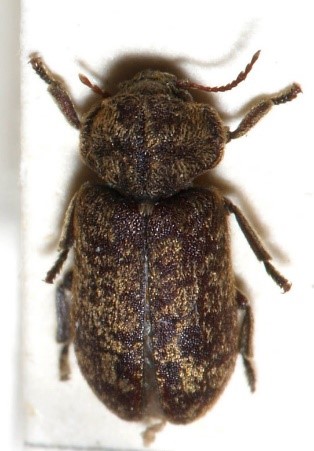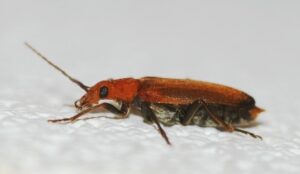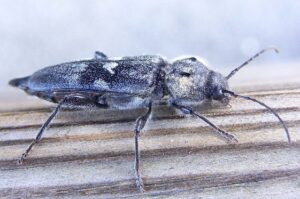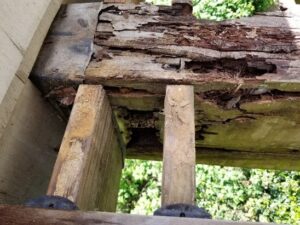Bostrichid Powderpost:
Bamboo borer
General Description
| · The bamboo borer is a very small beetle.
· The adult is dark reddish-brown, short, stout, cylindrical in shape, 3-4 mm long, and 1-1.5 mm wide. The pronotum is convex and a small part of the head is visible from above in front of the thorax. |

Credit: Wisut Sittichaya et al. |
The three-terminal segments of the adult antennae are swollen. The compound eyes are back and round. The antennae are ten-segmented and lamellate. The legs are reddish-brown.
- Eggs are spindle-shaped or elongate-oval, very small, milky-white, and nearly transparent. The eggs are individually laid in tunnels made by the adults.
- Larvae are approximately 3 to 4 mm long and milky white. The body is ‘C’-shaped. The head is round and the length is equal to the width. The mouthparts are black. The thorax is expanded and bears three legs, which decrease along its length. The spiracles are oval-round, which is longer than those in the sternum. Dense hair covers the tibia.
- Pupae are almost spindle-shaped, approximately 2.5 to 4 mm long, and milky white. The compound eye and mandibles are black.
Life Cycle and Common Characteristics
- The first peak of adult emergence is in February, the second is in June, and the third is in October. Both adults and larvae bore into the wood.
- The peak time for oviposition is in May and June.
- The female can lay about 20 eggs.
- The eggs hatch in 5 to 8 days.
- Larvae bore longitudinally and make a tunnel about 15 to 20 mm long.
- Larvae take about 40 days to develop.
- Pupation occurs in cocoons made at the terminal end of the larval tunnels.
- After approximately 4 days, the newly developed adult beetles may fly away or may explore other parts of the same bamboo.
- Starch, soluble carbohydrates, and proteins are nutritionally essential to bamboo borers.
- The life cycle from egg to adult completes in less than 2 months.
- Several generations each year.
Damages and Economic Implications
- The bamboo borers are the main pests of bamboo, attracted by the internal starch.
- They infest household furniture made of bamboo wood and turn the interior parts into a fine powder, which weakens them and makes the wood vulnerable to breakage.
- These borers also attack some stored foodstuffs such as spices, grains (corn, rice), flour, and other foods.
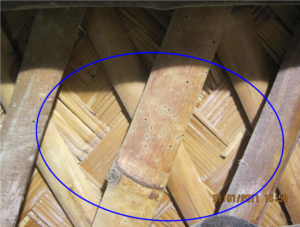
Extensive exit holes from Bamboo wood |

Damaged Bamboo wood infested with beetles |

